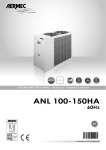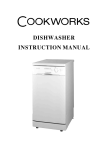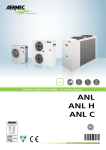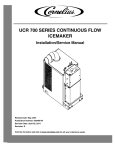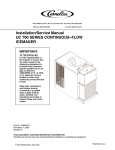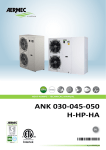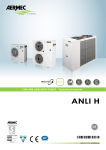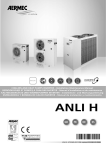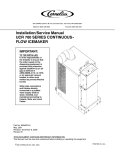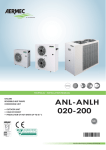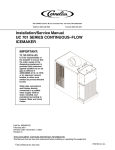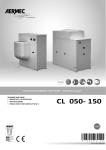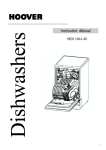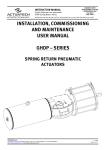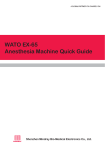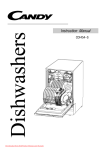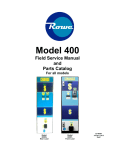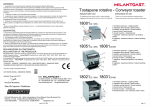Download ANL Technical and Installation Manual
Transcript
M L AXIAL UCONTRO OD SCROLL HEAT PUMPS - Technical - Installation manual HEAT PUMP ANL 100-150HA • EXTERNAL UNIT • HIGH EFFICENCY • HOT WATER PRODUCING UP TO 122°F / 50°c • POWER SUPPLY 60Hz 60Hz en IANL60HzPY. 1205. 6755517_02 Dear Customer, Thank you for choosing an AERMEC product. This product is the result of many years of experience and indepth engineering research, and it is built using top quality materials and advanced technologies. In addition, the CE mark guarantees that our appliances fully comply with the requirements of the European Machinery Directive in terms of safety. We constantly monitor the quality level of our products, and as a result they are synonymous with Safety, Quality, and Reliability. Product data may be subject to modifications deemed necessary for improving the product without the obligation to give prior notice. Thank you again. AERMEC S.p.A AERMEC S.p.A. reserves the right at any moment to make any modifications considered necessary to improve our products and is not obliged to add these modifications to machines that have already been fabricated, delivered or are under construction. INDEX 1. Description and choce of unit........................................................6 2. Product identification....................................................................6 3. 21. 21.1. Dimensions..................................................................................29 Anl 100 - 150 h|hp|ha version.................................................... 29 Ceck list.........................................................................................6 22. Antivibration positioning and distribution of percentage on supporting points....................................................................29 4. Configurator..................................................................................7 23. Hydraulic connections..................................................................30 5. Main cooling layout.......................................................................8 6. 6.1. 6.2. 6.3. 6.4. 6.5. 6.6. Description of components............................................................9 Chiller circuit...................................................................................... 9 Frame and fans.................................................................................. 9 Hydraulic circuit standard components............................................. 9 Hydraulic components for configurable versions............................... 9 Safety and control components....................................................... 10 Electric components........................................................................ 10 24. 24.1. 24.2. 24.3. Electrical data..............................................................................31 Compressor thermomagnetic.......................................................... 31 Pump thermomagnetic.................................................................... 31 Auxiliary thermomagnetic............................................................... 31 25. 25.1. 25.2. 25.3. Strat-up.......................................................................................32 Preliminary operations to be made without tension....................... 32 The following operations are performed when the unit is powered..32 Machine commissioning.................................................................. 32 7. Accessories compatibilty table.....................................................11 8. Technical data .............................................................................12 9. 9.1. 9.2. 9.3. Operating limits...........................................................................14 Cooling mode................................................................................... 14 Heating mode (for heating pump)................................................... 14 Project data...................................................................................... 14 26. 26.1. 26.2. 26.3. 26.4. 26.5. 26.6. Functioning features....................................................................33 Set point in cooling mode................................................................ 33 Set point in riscaldamento............................................................... 33 Compressor start-up delay............................................................... 33 Circulation pump.............................................................................. 33 Anti-freeze alarm............................................................................. 33 Water flow rate alarm...................................................................... 33 10. Performance in cooling mode......................................................15 10.1. Anl 100.......................................................................................... 15 10.2. Anl 150.......................................................................................... 15 10.3. Anl 100 hp-ha.............................................................................. 16 10.4. Anl 150 hp-ha.............................................................................. 16 11. 11.1. 11.2. 11.3. 11.4. Performance in heating mode......................................................17 Anl 100 h....................................................................................... 17 Anl 150 h....................................................................................... 17 Anl 100 hp-ha.............................................................................. 18 Anl 150 hp-ha.............................................................................. 18 12. 11.5. Ethylene glycol solutions..............................................................19 How to interpret glycol curves......................................................... 19 13. 13.1. 13.2. Pressure drop..............................................................................20 System side - pressure drop only cooling version............................ 20 Water filter - pressure drop............................................................. 20 14. Useful heads................................................................................21 15. 15.1. 15.2. Storage tank..............................................................................22 Minimum/maximum content of system water ............................... 22 Expansion vessel calibration ........................................................... 22 16. Sound data..................................................................................23 17. Parameter calibration of safety and control.................................23 18. 18.1. 18.2. General warnings for the installer................................................24 Preservation of the documentation................................................. 24 Warnings regarding safety and installation standards .................... 24 19. Selection and place of installation................................................25 20. 20.1. 20.2. 20.3. Hydraulic circuits of principle.......................................................26 Hydraulic circuit for internal and external anl "h" (standard)......... 26 Circuito idraulico interno ed esterno ad anl “hp"............................ 27 Hydraulic circuit for internal and external anl "ha"........................ 28 27.Maintenance...............................................................................34 27.2. Hydraulic circuit............................................................................... 34 27.3. Emptying the system........................................................................ 34 27.4. Electrical circuit................................................................................ 34 27.5. Cooling circuit.................................................................................. 34 27.6.Mechanical....................................................................................... 34 27.1. Extraordinary maintenance............................................................. 34 28. Disposal.......................................................................................34 29. 29.1. 29.2. List of controls for the guided procedure......................................35 How to modify a parameter in the user menu................................ 35 How to modify a parameter in the installer menu........................... 35 EN 1. DESCRIPTION AND CHOCE OF UNIT Standards and Directives respected on designing and constructing the unit: Protection rating 1. IP 24 Acoustic part: 1. ISO DIS 9614/2 (intensimetric method)) 2. SOUND POWER (EN ISO 9614-2) 3. SOUND PRESSURE (EN ISO 3744) Refrigerant GAS: This unit contains fluoride gases with greenhouse effect covered by the Kyoto Protocol. Maintenance and disposal must only be performed by qualified staff. Chillers and heat pumps for outdoor condensed in the air with R410A Series ANL have been designed and manufactured to satisfy heating and cooling needs and the production of domestic hot water (DHW) in medium to small commercial or residential buildings. These units, have extremely silent functioning and are highly efficient and reliable, thanks to the use of exchangers with a large exchange surface and lownoise high-efficiency scroll compressors. The versions can be in different set-ups at the same time in order to satisfy a wide range of plant engineering solutions: "°" Standard "P" Pumps "A" Pump |Storage tank They are available in the following versions: 2. Standard: UL 1995 Heating and cooling equipment. ANL "°" Standard ANL "H" Heat pumps Product identification ANL are identified by the following: ANSI/NFPA Standard 70 National Electrical code (N.E.C.). − PACKAGING LABEL: that includes the product identification data. − CSA C.22.1.- C.22.2 Safety Standard Electrical Installation. TECHNICAL PLATE: placed on the right strut side. (see TAV.1) NOTE: If the identification plate, or any other means to identify the product, is tampered with, removed or missing, installation and maintenance operations are hampered. TAV.1 3. ceck list Chiller circuit Scroll compressor Water side heat exchanger Source side heat exchanger Dehydrator filter Thermostatic valve Solenoid valve By-pass valve of hot gas injecton Indicator for liquid passage 4-way cycle reverse valve One way valves Liquid storage tank High pressure switch Low pressure switch High pressure transducer Low pressure transducer Desuperheater Tap the liquid and discharge 6 TECHNICAL PLATE Standard Standard Standard Standard Standard Standard No Standard Standard Standard Standard Standard No Standard Standard No No Hydraulic circuit Version "°" ANL100 Water filter Standard Differential pressure switch Standard Flow switch No Safety valve No Air vent Standard Expansion tank No ANL150 Standard Standard No No Standard No Hydraulic circuit Version "P" Water filter Differential pressure switch Flow switch Safety valve Air vent Pump Expansion tank 100 Standard Standard No Standard Standard Standard Standard 150 Standard Standard No Standard Standard Standard Standard Hydraulic circuit Version "A" Water filter Differential pressure switch Flow switch Safety valve Air vent Pump Expansion tank Storge tank 100 Standard Standard No Standard Standard Standard Standard Standard 150 Standard Standard No Standard Standard Standard Standard Standard 1205. 6755517_02 EN 4. configurator FIELD 1, 2 ,3 CODE ANL 4, 5, 6 SIZE 100 -150 7 Model H heat pump Version ° P A standard with pump with storage tank and pump 8 9 10 Heat recovery without heat recovery units ° Coils ° 11 Field of use ° 12 13 in aluminium temperature of water produced up to 39.2°F / +4°C Evaporator ° standard, PED normative Supply 6 7 3~220-60Hz 3~460-60Hz 1205. 6755517_02 7 EN 5. MAIN COOLING LAYOUT CV VIC F HPT AL HPS CP LS LPT TEV BHE FS IN EV pompa CV OUT KEY CP HPT HPS LPT VIC CN CV F AL TEV BHE V 8 Compressor High pressure transducer High pressure switch Low pressure transducer Cycle reversing valve Finned coil One-way valve Dehydrator filter Liquid storage tank Thermostatic valve Plate exchanger Fan/s 1205. 6755517_02 MF EN 6. DESCRIPTION OF COMPONENTS 6.1. chiller circuit scroll Compressors High efficiency scroll-type hermetic compressors, assembled on elastic antivibration supports, driven by a 2-pole electric motor with internal thermal protection. of the electric heater casing included as standard. The heater is automatically powered when the unit stops, provided that the unit is kept under tension. Water side heat exchanger Of the plate-type (AISI 316), externally insulated with closed cell material to reduce thermal dispersion. Fitted, as standard, with antifreeze heater. 6.1.1. water features PH Electric conductivity Chloride ions Sulphuric acid ions Total iron Alkalinity M Total hardness Sulphur ions ammonia ions Silicone ions 6-8 less than 200 mV/cm (77°F / 25°C) less than 50 ppm less than 50 ppm less than 0.3 ppm less than 50 ppm less than 50 ppm none none less than 30 ppm Source side heat exchanger Made with copper pipes and aluminium louvered fins blocked by mechanical expansion of the pipes. Provided with protective grid. dehydrator filter Hermetic-mechanical with cartridges made of ceramic and hygroscopic material, able to withhold impurities and any traces of humidity present in the cooling circuit. 6.2. FRAME AND FANS SUPPORT FRAME Load-bearing structure Made of hot-galvanised steel sheet of a suitable thickness, varnished with polyester powders able to resist atmospheric agents over time. Ventilation Unit Axial fan, balanced statically and dynamically. The electric fans are protected electrically by magnet-circuit breakers and mechanically by anti-intrusion metal grids, according to the IEC EN 60335-2-40 Standard. 6.3. HYDRAULIC CIRCUIT Standard components Water filter Equipped with steel filtering mesh; prevents the heat exchangers from clogging. It is indispensable in order to prevent serious damage to the plate exchanger. Differential pressure switch It checks that here is water circulation inside the heat exchangers. Adversary, it blocks the unit. Safety valve Equipped with a piped discharger and intervenes by discharges the over pressure in case of anomalous pressures. Air Vent Assembled on the upper part of the hydraulic system; it releases any air bubbles that may be present in the system. ONE WAY VALVES Allow one-way flow of the fluid. 6.4. thermostatic valve The mechanical valve, with external equaliser positioned at the evaporator inlet, modulates the flow of gas to the evaporator, according to the heat load, in order to ensure a correct heating level of the intake gas. Circulation pump Depending on the characteristics of the pump chosen, it offers a useful head to overcome the pressure drops in the system. Solenoid valve The valve closes when the compressor turns off, preventing the flow of refrigerant gas towards the evaporator. Indicator for liquid passage with humidity presence signal Used to check the refrigerant gas load and the eventual presence of humidity in the cooling circuit. 4-WAY CYCLE REVERSE VALVE Inverts the flow of refrigerant gas. 1205. 6755517_02 One-way valves Allows the passage of the refrigerant in just one direction. liquid storage tank Compensates the difference in volume between louveres coil and plate exchanger, withholding excess liquid. HYDRAULIC components FOR CONFIGURABLE VERSIONS Expansion tank With nitrogen pre-load membrane. Safety valve Equipped with a piped discharger and intervenes by discharges the over pressure in case of anomalous pressures. STORAGE TANK In order to reduce the thermal dispersion and eliminate the phenomenon of the formation of condensation, it is insulated with polyurethane material of a suitable thickness. It is required to reduce the number of peaks of the compressor and to even the temperature 9 EN of water to be sent to the utilities. 6.5. Electric Regolation modu control SAFETY AND CONTROL COMPONENTS Temperature control of the output water with proportional-integral algorithm: maintains average output temperature at value set - Self-adapting differential switch: guarantees minimum functioning times of the compressor in systems with low water content. - Intelligent defrosting for pressure reduction: allows to determine when the coil is effectively defrosted, avoiding useless defrosting - Set-point compensation with external temperature: reduces energy consumption - Pre-alarms with automatic reset: in the case of alarm, a certain number of re-starts are allowed before the definitive block alarm on the ∆T: to identify wiring errors (reverse rotation) or blocked cycle reversing valve - Compressor functioning hours count. - Compressor peak count. - Historical alarms - Autostart after voltage drop. - Local or remote control High pressure switch With fixed calibration, placed on high pressure side of cooling circuit, inhibits functioning of compressor if abnormal work pressure occurs. High pressure transducer Placed on high pressure side of cooling circuit, signals the work pressure to control board, generating a pre-warning in case abnormal pressure occurs. Low pressure transducer Allows displaying, on the microprocessor board display, the value of the compressor's suction pressure (one per circuit) on the low-pressure side of the cooling circuit. Display of the start of the unit: 1. Voltage presence 2. compressor ON/OFF 3. functioning mode (hot/cold) 4. alarm active 6.6. ELECTRIC COMPONENTS Electric Control Board Contains the power section and the management of controls and safety devices. It is in compliance with the IEC 60204-1 Standard and the Directives regarding electromagnetic compatibility EMC 89/336/ EEC and 92/31/EEC. Probes, transducers and parameters display 1. Water outlet 2. water inlet 3. Coil temperature (heat pumps) 4. Pressing gas temperature 5. External air temperature (heat pumps) 6. Pressure delivery (heat pumps) 7. Intake pressure (heat pumps) 8. Temperature error (sum of the proportional and integral error) 9. Stand-by times for start-up/switch-off of the compressor 10. Alarms management: 11. Low pressure 12. High pressure (primary alarm: switch directly blocks supply to compressor) 13. High discharge temperature 14. Anti-freeze 15. Water differential flow switch. Alarm on the ∆T Door-lock isolating switch The electric control board can be accessed by removing the voltage. Act on the opening lever of the control board itself. This lever can be locked using one or more padlocks during maintenance interventions to prevent the machine being powered up accidentally. Control board Allows complete control of the appliance. For a more in-depth description please refer to the user manual. − compressors magnet circuit-breaker protection. − fans magnet-circuit breakers protection; − auxiliary magnet circuit-breaker protection − Heat exchanger inlet/outlet water temperature probes − Gas temperature probe one on the for pressing line and coil − External air temperature probe − Alarms with automatic reset with limited number of re-starts before blocking. − ON/OFF external contact − Change season from external contact For further information please refer to user manual. ► For further information please refer to user manual moducontrol CONTROL PANEL 10 1205. 6755517_02 EN 7. accessories compatibilty table VT Group of anti-vibration, to be installed under the base. ANL MODELs 100 150 MECHANICAL ACCESSORY VT P A 1205. 6755517_02 15 15 11 EN 8. technical data TECHNICAL DATA Models Power supply M.U. ANL100 ANL150 Alls Alls Tons 6,57 8,16 H Alls kW 8,24 9,48 COOLING MODE Cooling capacity Total input power Water flow rate HP-HA Alls kW 8,99 10,98 Alls Alls gpm 16 20 Evaporator pressure drops H - psi 3,80 3,52 Filter pressure drop H - psi 0,55 0,84 Total pressure drop H - psi 4,35 4,36 Useful head HP-HA - psi 14,65 19,14 Alls Alls BTU/h 94755 111850 HEATING MODE Heating capacity Total input power H Alls kW 8,29 9,57 HP-HA Alls kW 9,04 11,07 Water flow rate Alls Alls gpm 21 25 Evaporator pressure drops H - psi 6,38 5,15 Filter pressure drop H - psi 0,96 1,31 Total pressure drop H - psi 7,34 6,45 Useful head HP-HA - psi 10,44 14,94 H Alls W/W 9,58 10,34 HP-HA Alls W/W 8,78 8,92 H Alls W/W 3,35 3,43 HP-HA Alls W/W 3,07 2,96 Alls Alls BTU/W 16,39 17,73 H 220-3-60 A 31,40 36,70 H 460-3-60 A 17,10 19,64 ENERGY INDEX EER COP IPLV HEATING (AHRI CONDITIONS) Inlet water temperature Outlet water temperature External air temperature COOLING (AHRI CONDITIONS) Outlet water temperature Flow rate External temperature ELECTRICAL DATA 40°C / 104°F 45°C / 113°F 7°C / 44.6°F b.s 6°C / 42.8°F b.u. 6,7°C / 44,6°F 0,043l/s per kW 35°C / 95°F AHRI conditions: leaving water 6,7°C / 44,6°F flow rate 0,043 l/s per kW (full load) Load 100% air 35°C / 95°F Load 75% air 26,7°C / 80,06°F Load 50% air 18,3°C / 64,94°F Load 25% air 12,8°C / 55,04°F Sound power Aermec determines sound power values in agreement with the 9614-2 Standard. Sound Pressure Sound pressure measured in free field conditions with reflective surface (directivity factor Q=2) at 394 in/10mt distance from external surface of unit, in compliance with ISO 3744 regulations. 12 Imput current on COOLING Imput current on HEATING Peak current (LRA) MCA MOP HP-HA 220-3-60 A 34,26 42,51 HP-HA 460-3-60 A 18,66 22,75 H 220-3-60 A 31,59 37,05 H 460-3-60 A 17,21 19,83 HP-HA 220-3-60 A 34,45 42,86 HP-HA 460-3-60 A 18,76 22,93 H 220-3-60 A 167,40 192,20 H 460-3-60 A 81,40 94,30 HP-HA 220-3-60 A 171,00 198,40 HP-HA 460-3-60 A 83,40 97,50 H 220-3-60 A 51,30 60,60 H 460-3-60 A 25,50 31,80 HP-HA 220-3-60 A 54,90 66,80 HP-HA 460-3-60 A 27,50 35,00 H 220-3-60 A 70,00 80,00 H 460-3-60 A 35,00 45,00 HP-HA 220-3-60 A 75,00 90,00 HP-HA 460-3-60 A 35,00 45,00 1205. 6755517_02 EN TECHNICAL DATA Models Power supply M.U. ANL100 ANL150 24 24 IP PROTECTION IP Alls - - SCROLL COMPRESSORS Number / Circuit Alls - n°/n° 2/1 2/1 Resistance sump compressor Alls - n° x W 2 x 35 2 x 35 Capacity controls Alls - % 0 - 50 - 100 0 - 50 - 100 R410A refrigerant Alls - lib 28,0 35,3 Oil compressor Alls - lib 3,5 3,5 Quantity Alls - n° 1,00 1,00 Water content Alls - dm3 1,90 2,50 Hydraulic connection Alls - Ø 1"¼ 1"¼ HA - n°/gl 1/26,42 1/26,42 Expansion vassel HP-HA - n°/gl 1/2,11 1/2,11 Expansion vassel calibration HP-HA - bar 1,50 1,50 CHARGE SYSTEM SIDE EXCHANGER HYDRONIC KIT SYSTEM SIDE Storage tank EXPANSION VASSEL PUMP Imput power Imput current - - kW 0,75 1,50 - 220-3-60 A 3,6 6,2 - 460-3-60 A 2,0 3,2 - - n°/bar 1/6 1/6 SAFETY VALVE Safety valve HEATING (AHRI CONDITIONS) Inlet water temperature Outlet water temperature External air temperature 6°C / 42.8°F b.u. FAN 40°C / 104°F 45°C / 113°F 7°C / 44.6°F b.s COOLING (AHRI CONDITIONS) Outlet water temperature 6,7°C / 44,6°F Flow rate 0,043l/s per kW External temperature 35°C / 95°F AHRI conditions: leaving water 6,7°C / 44,6°F flow rate 0,043 l/s per kW (full load) Load 100% air 35°C / 95°F Load 75% air 26,7°C / 80,06°F Load 50% air 18,3°C / 64,94°F Load 25% air 12,8°C / 55,04°F Sound power Aermec determines sound power values in agreement with the 9614-2 Standard. Quantity - - n° 2 2 Air flow - - cfm 7775 7068 Input current - 2 2 Input power - - kW 0,6 0,6 Sound pressure - - db(A) 76 77 Sound power - - db(A) 44 45 A SOUND DATA DIMENSION Height - - in 57 57 Width - - in 30 30 Depth H Weight - in 69 69 - lib 650 710 HP - lib 690 756 HA - lib 800 866 Sound Pressure Sound pressure measured in free field conditions with reflective surface (directivity factor Q=2) at 394 in/10mt distance from external surface of unit, in compliance with ISO 3744 regulations. 1205. 6755517_02 13 EN 9. OPERATING LIMITS The devices in their standard configuration, are not suitable for installation in a saline environment. To the limits of operation, please refer to the diagram, valid for AHRI standard conditions. External air temperature 9.1. Wind breaks should be implemented if the unit is installed in particularly windy areas, to prevent a malfunction of the unit. cooling mode °F °C 114.8 104 95 46 40 35 86 77 68 59 30 25 20 15 4 5 6 7 8 9 10 11 12 13 14 15 16 17 18 °C 64.4 62.6 60.8 59.0 57.2 55.4 53.6 51.8 50.0 48.2 46.4 44.6 42.8 41.0 39.2 °F Temperature of water produced Temperature of the water produced CONDENSER 9.2. hEATING MODE (FOR HEATING PUMP) °F °C 140 131 60 55 122 113 104 50 45 40 95 86 77 68 59 35 30 25 20 15 -10 -5 0 5 10 15 20 25 °C 14 23 32 41 50 59 68 77 °F External air temperature b.s. 9.3. pROJECT DATA Acceptable maximum pressure Acceptable maximum temperature Acceptable minimum temperature 14 ATTENTION When the unit is installed in particularly windy areas, we recommend installing wind barriers if wind speed exceeds 2.5 m/s” bar °C °C High pressure side 42 120 -10 Low pressure side 25 52 -16 ATTENTION Contact our technical sales department if the unit needs to operated outside the operating limits. 1205. 6755517_02 EN 10. PERFORMANCE IN COOLING MODE 10.1. ANL 100 External air temeperature Temp. of Temp. of water water produced produced (C°) (F°) 20°C 25°C 30°C 35°C 40°C 46°C 68°F 77°F 86°F 95°F 104°F 114.8°F Pc Pe EER Pc Pe EER Pc Pe EER Pc Pe EER Pc Pe EER Pc Pe EER Tons kW BTU/h/W Tons kW BTU/h/W Tons kW BTU/h/W Tons kW BTU/h/W Tons kW BTU/h/W Tons kW BTU/h/W 4 39.2 7,49 5,69 15,82 7,07 6,49 13,07 6,63 7,35 10,84 6,20 8,10 9,20 5,76 8,78 7,88 5,25 9,35 6,74 6 42.8 7,79 5,69 16,45 7,35 6,54 13,50 6,90 7,39 11,23 6,46 8,15 9,51 6,01 8,87 8,13 5,48 9,43 6,98 7 44.6 7,94 5,78 16,51 7,49 6,58 13,67 7,04 7,44 11,38 6,57 8,24 9,58 6,13 8,87 8,31 5,60 9,48 7,09 8 46.4 8,09 5,82 16,71 7,64 6,63 13,84 7,18 7,47 11,54 6,71 8,24 9,78 6,25 8,91 8,42 5,71 9,49 7,23 10 50 8,39 5,87 17,18 7,92 6,72 14,16 7,45 7,52 11,89 6,96 8,33 10,04 6,49 8,96 8,70 - - - 12 53.6 8,68 5,92 17,63 8,20 6,76 14,57 7,70 7,61 12,15 7,22 8,38 10,35 6,73 9,01 8,98 - - - 14 57.2 8,97 6,00 17,95 8,46 6,81 14,93 7,97 7,66 12,49 7,46 8,42 10,64 6,96 9,04 9,25 - - - 16 60.8 9,25 6,04 18,38 8,74 6,85 15,33 8,22 7,70 12,82 7,70 8,47 10,93 7,19 9,09 9,50 - - - 18 64.4 9,52 6,09 18,78 9,00 6,95 15,57 8,47 7,79 13,07 7,94 8,50 11,22 7,44 9,18 9,73 - - - 10.2. ANL 150 External air temeperature Temp. of Temp. of water water produced produced (C°) (F°) 20 25 30 35 40 46 68°F 77°F 86°F 95°F 104°F 114.8°F Pc Pe EER Pc Pe EER Pc Pe EER Pc Pe EER Pc Pe EER Pc Pe EER Tons kW BTU/h/W Tons kW BTU/h/W Tons kW BTU/h/W Tons kW BTU/h/W Tons kW BTU/h/W Tons kW BTU/h/W 4 39.2 9,30 6,55 17,07 8,77 7,47 14,11 8,23 8,45 11,69 7,70 9,32 9,92 7,15 10,10 8,51 6,52 10,76 7,28 6 42.8 9,68 6,55 17,75 9,13 7,53 14,57 8,57 8,50 12,12 8,01 9,38 10,26 7,46 10,20 8,78 6,80 10,85 7,53 7 44.6 9,86 6,65 17,82 9,30 7,57 14,75 8,74 8,55 12,28 8,16 9,48 10,34 7,62 10,20 8,97 6,95 10,91 7,65 8 46.4 10,05 6,69 18,03 9,49 7,63 14,94 8,92 8,60 12,45 8,33 9,48 10,55 7,76 10,25 9,09 7,09 10,92 7,80 10 50 10,42 6,75 18,54 9,83 7,73 15,28 9,25 8,66 12,83 8,65 9,58 10,84 8,06 10,30 9,39 - - - 12 53.6 10,78 6,81 19,02 10,18 7,78 15,72 9,56 8,76 13,11 8,96 9,64 11,16 8,36 10,36 9,69 - - - 14 57.2 11,14 6,91 19,37 10,50 7,83 16,11 9,89 8,81 13,48 9,26 9,68 11,48 8,65 10,41 9,98 - - - 16 60.8 11,48 6,95 19,83 10,85 7,88 16,54 10,20 8,86 13,83 9,56 9,74 11,79 8,93 10,46 10,25 - - - 18 64.4 11,82 7,01 20,26 11,18 7,99 16,80 10,52 8,96 14,10 9,86 9,78 12,10 9,23 10,56 10,50 - - - KEY Pc: Cooling capacity Pe: Input power in cooling mode - Inlet water temperature - Outlet water temeprature - External air temperature - ∆t 1205. 6755517_02 12°C / 53.6°F 7°C / 44.6°F 35°C / 95°F 5°C / 41°F 15 EN 10.3. ANL 100 HP-HA External air temeperature Temp. of Temp. of water water produced produced (C°) (F°) 20°C 25°C 30°C 35°C 40°C 46°C 68°F 77°F 86°F 95°F 104°F 114.8°F Pc Pe EER Pc Pe EER Pc Pe EER Pc Pe EER Pc Pe EER Pc Pe EER Tons kW BTU/h/W Tons kW BTU/h/W Tons kW BTU/h/W Tons kW BTU/h/W Tons kW BTU/h/W Tons kW BTU/h/W 4 39.2 7,49 6,21 14,50 7,07 7,08 11,98 6,63 8,02 9,93 6,20 8,84 8,43 5,76 9,58 7,23 5,25 10,20 6,18 6 42.8 7,79 6,21 15,08 7,35 7,14 12,37 6,90 8,06 10,29 6,46 8,89 8,72 6,01 9,67 7,46 5,48 10,29 6,40 7 44.6 7,94 6,30 15,13 7,49 7,18 12,53 7,04 8,11 10,43 6,57 8,99 8,78 6,13 9,67 7,62 5,60 10,34 6,50 8 46.4 8,09 6,35 15,32 7,64 7,23 12,69 7,18 8,16 10,58 6,71 8,99 8,96 6,25 9,72 7,72 5,71 10,35 6,62 10 50 8,39 6,40 15,75 7,92 7,33 12,98 7,45 8,21 10,90 6,96 9,09 9,21 6,49 9,77 7,98 - - - 12 53.6 8,68 6,45 16,16 8,20 7,37 13,35 7,70 8,31 11,14 7,22 9,14 9,48 6,73 9,82 8,23 - - - 14 57.2 8,97 6,55 16,45 8,46 7,43 13,68 7,97 8,36 11,45 7,46 9,18 9,76 6,96 9,87 8,48 - - - 16 60.8 9,25 6,59 16,85 8,74 7,47 14,05 8,22 8,40 11,75 7,70 9,24 10,01 7,19 9,92 8,71 - - - 18 64.4 9,52 6,65 17,21 9,00 7,58 14,27 8,47 8,50 11,98 7,94 9,28 10,28 7,44 10,02 8,92 - - - 10.4. ANL 150 HP-HA External air temeperature Temp. of Temp. of water water produced produced (C°) (F°) 20°C 25°C 30°C 35°C 40°C 46°C 68°F 77°F 86°F 95°F 104°F 114.8°F Pc Pe EER Pc Pe EER Pc Pe EER Pc Pe EER Pc Pe EER Pc Pe EER Tons kW BTU/h/W Tons kW BTU/h/W Tons kW BTU/h/W Tons kW BTU/h/W Tons kW BTU/h/W Tons kW BTU/h/W 4 39.2 9,30 7,58 14,74 8,77 8,65 12,18 8,23 9,79 10,09 7,70 10,80 8,57 7,15 11,70 7,35 6,52 12,46 6,28 6 42.8 9,68 7,58 15,33 9,13 8,72 12,58 8,57 9,84 10,46 8,01 10,86 8,86 7,46 11,82 7,58 6,80 12,57 6,50 7 44.6 9,86 7,70 15,38 9,30 8,77 12,74 8,74 9,91 10,60 8,16 10,98 8,92 7,62 11,82 7,74 6,95 12,63 6,61 8 46.4 10,05 7,75 15,57 9,49 8,84 12,90 8,92 9,96 10,75 8,33 10,98 9,11 7,76 11,87 7,85 7,09 12,65 6,73 10 50 10,42 7,82 16,01 9,83 8,95 13,19 9,25 10,03 11,08 8,65 11,10 9,36 8,06 11,93 8,11 - - - 12 53.6 10,78 7,88 16,42 10,18 9,01 13,57 9,56 10,14 11,32 8,96 11,16 9,64 8,36 12,00 8,37 - - - 14 57.2 11,14 8,00 16,72 10,50 9,07 13,91 9,89 10,21 11,64 9,26 11,22 9,92 8,65 12,05 8,62 - - - 16 60.8 11,48 8,05 17,12 10,85 9,12 14,28 10,20 10,26 11,94 9,56 11,28 10,18 8,93 12,12 8,85 - - - 18 64.4 11,82 8,12 17,49 11,18 9,25 14,51 10,52 10,38 12,17 9,86 11,33 10,45 9,23 12,23 9,06 - - - KEY Pc: Cooling capacity Pe: Input power in cooling mode - Inlet water temperature - Outlet water temeprature - External air temperature - ∆t 16 12°C / 53.6°F 7°C / 44.6°F 35°C / 95°F 5°C / 41°F 1205. 6755517_02 EN 11. Performance in heating mode 11.1. ANL 100 H External External air teme- air temeperature perature °C °F Water temperature produced 20°C 25°C 30°C 35°C 40°C 45°C 50°C 68°F 77°F 86°F 95°F 104°F 113°F 122°F Ph Pe COP BTU/h Kw W/W BTU/h Ph Pe COP Kw W/W BTU/h Ph Pe COP Kw W/W BTU/h Ph Pe COP Kw W/W BTU/h Ph Pe COP Kw W/W BTU/h Ph Pe COP Kw W/W BTU/h Ph Pe COP Kw W/W -10 14 61624 0,63 28,82 60676 4,27 4,16 59696 6,32 2,77 58585 7,33 2,34 - - - - - - - - - -8 17.6 65937 0,62 31,32 64466 4,27 4,42 63094 6,32 2,92 61689 7,32 2,47 60121 7,78 2,26 - - - - - - -6 21.2 70184 0,62 33,34 68191 4,27 4,68 66427 6,32 3,08 64760 7,32 2,59 63029 7,78 2,37 61166 8,24 2,18 - - - -4 24.8 74399 0,62 35,34 71883 4,27 4,93 69694 6,32 3,23 67766 7,32 2,71 65904 7,79 2,48 64009 8,25 2,27 61983 9,24 1,97 -2 28.4 78516 0,63 36,73 75510 4,27 5,18 72961 6,33 3,38 70740 7,33 2,83 68747 7,79 2,59 66819 8,25 2,37 64891 9,24 2,06 0 32 82633 0,64 38,07 79104 4,28 5,42 76164 6,33 3,52 73680 7,33 2,95 71524 7,80 2,69 69629 8,26 2,47 67799 9,25 2,15 2 35.6 77928 0,64 35,90 78614 4,29 5,37 78124 6,34 3,61 76784 7,34 3,07 74922 7,80 2,82 72929 8,27 2,58 71099 9,26 2,25 0,65 44,08 94821 4 39.2 97140 4,30 6,46 92893 6,35 4,29 91194 7,35 3,64 89560 7,81 3,36 87861 8,28 3,11 85900 9,27 2,71 6 42.8 103381 0,66 46,22 100702 4,31 6,85 98447 6,36 4,53 96422 7,35 3,84 94526 7,82 3,54 92533 8,29 3,27 90311 9,28 2,85 7 44.6 106355 0,67 46,86 103479 4,31 7,04 101029 6,37 4,65 98872 7,45 3,89 96814 7,83 3,62 94755 8,29 3,35 92337 9,28 2,92 8 46.4 109197 0,67 48,11 106158 4,32 7,20 103545 6,37 4,76 101225 7,36 4,03 99003 7,83 3,71 96716 8,30 3,42 94232 9,29 2,97 97761 10 50 114752 0,67 49,84 111321 4,33 7,54 108315 6,38 4,97 105636 7,37 4,20 103087 7,84 3,86 100506 8,30 3,55 9,30 3,08 12 53.6 120143 0,68 51,45 116287 4,34 7,86 112922 6,39 5,18 109883 7,38 4,36 106975 7,85 4,00 104067 8,31 3,67 100996 9,31 3,18 3,28 14 57.2 125534 0,69 53,01 121254 4,34 8,19 117464 6,40 5,38 114033 7,39 4,52 110798 7,86 4,13 107531 8,32 3,79 104133 9,31 16 60.8 131024 0,70 54,57 126318 4,35 8,52 122136 6,40 5,59 118281 7,39 4,69 114654 7,87 4,27 111027 8,33 3,91 107302 9,32 3,37 18 64.4 136807 0,70 56,98 131644 4,35 8,87 127005 6,41 5,81 122724 7,40 4,86 118705 7,87 4,42 114719 8,33 4,04 110602 9,32 3,48 20 68 143015 0,70 59,56 137330 4,35 9,26 132232 6,41 6,05 127560 7,40 5,05 123084 7,87 4,59 118705 8,33 4,18 114229 9,32 3,59 20°C 25°C 30°C 35°C 40°C 45°C 50°C 68°F 77°F 86°F 95°F 104°F 113°F 122°F 11.2. ANL 150 H External External air teme- air temeperature perature °C °F Water temperature produced Ph Pe COP BTU/h Kw W/W BTU/h Ph Pe COP Kw W/W BTU/h Ph Pe COP Kw W/W BTU/h Ph Pe COP Kw W/W BTU/h Ph Pe COP Kw W/W BTU/h Ph Pe COP Kw W/W BTU/h Ph Pe COP Kw W/W -10 14 72741 0,72 29,47 71623 4,93 4,26 70466 7,30 2,83 69154 8,46 2,40 - - - - - - - - - -8 17.6 77832 0,71 32,03 76097 4,93 4,52 74477 7,30 2,99 72818 8,45 2,53 70967 8,98 2,32 - - - - - - - - -6 21.2 82846 0,71 34,09 80493 4,93 4,79 78411 7,30 3,15 76444 8,45 2,65 74400 8,98 2,43 72201 9,51 2,22 -4 24.8 87822 0,71 36,14 84852 4,93 5,04 82268 7,30 3,30 79992 8,45 2,78 77794 8,99 2,54 75557 9,53 2,32 73165 10,67 2,01 -2 28.4 92681 0,72 37,55 89133 4,93 5,30 86125 7,31 3,45 83502 8,46 2,89 81149 8,99 2,65 78874 9,53 2,43 76598 10,67 2,10 0 32 97541 0,73 38,92 93375 4,94 5,54 89904 7,31 3,60 86973 8,46 3,01 84427 9,00 2,75 82190 9,54 2,53 80031 10,68 2,20 2 35.6 91987 0,73 36,71 92797 4,95 5,49 92218 7,32 3,69 90637 8,47 3,14 88439 9,00 2,88 86086 9,55 2,64 83926 10,69 2,30 - 4 39.2 114666 0,75 45,07 111927 4,96 6,61 109652 7,33 4,38 107646 8,48 3,72 105718 9,01 3,44 103712 9,56 3,18 101398 10,71 2,78 6 42.8 122032 0,76 47,26 118870 4,97 7,00 116208 7,34 4,64 113817 8,49 3,93 111580 9,02 3,62 109227 9,57 3,34 106605 10,72 2,92 7 44.6 125542 0,77 47,92 122148 4,97 7,20 119255 7,36 4,75 116710 8,60 3,98 114280 9,04 3,71 111850 9,57 3,43 108996 10,72 2,98 8 46.4 128897 0,77 49,20 125311 4,99 7,37 122225 7,36 4,87 119487 8,50 4,12 116864 9,04 3,79 114164 9,58 3,49 111233 10,73 3,04 10 50 135454 0,78 50,96 131404 5,00 7,71 127856 7,37 5,09 124693 8,51 4,29 121685 9,05 3,94 118638 9,58 3,63 115398 10,74 3,15 12 53.6 141818 0,79 52,61 137267 5,01 8,03 133294 7,38 5,29 129707 8,52 4,46 126275 9,06 4,09 122842 9,59 3,75 119217 10,75 3,25 3,35 14 57.2 148182 0,80 54,20 143129 5,01 8,38 138655 7,39 5,50 134606 8,54 4,62 130787 9,07 4,23 126930 9,60 3,87 122919 10,75 16 60.8 154662 0,81 55,80 149108 5,02 8,71 144171 7,39 5,72 139620 8,54 4,79 135339 9,08 4,37 131057 9,61 3,99 126660 10,76 3,45 18 64.4 161488 0,81 58,26 155394 5,02 9,07 149918 7,40 5,94 144865 8,55 4,97 140121 9,08 4,52 135416 9,61 4,13 130556 10,76 3,56 20 68 168816 0,81 60,90 162105 5,02 9,47 156089 7,40 6,18 150573 8,55 5,16 145289 9,08 4,69 140121 9,61 4,27 134837 10,76 3,67 KEY Ph: Heathing capacity Pe: Input power IN heating mode - Inlet water temperature - Outlet water temperature - External air temperature - ∆t 1205. 6755517_02 40°C / 104°F 45°C / 113°F b.s. 7°C / 44.6°F 5°C / 41°F 17 EN 11.3. ANL 100 HP-HA External External air teme- air temeperature perature °C °F Water temperature produced 20°C 25°C 30°C 35°C 40°C 45°C 50°C 68°F 77°F 86°F 95°F 104°F 113°F 122°F Ph Pe COP Pe COP Pe COP Pe COP BTU/h Kw W/W BTU/h Ph Kw W/W BTU/h Ph Kw W/W BTU/h Ph Kw W/W BTU/h Ph Pe COP Kw W/W BTU/h Ph Pe COP Kw W/W BTU/h Ph Pe COP Kw W/W -10 14 61624 0,68 26,43 60676 4,66 3,82 59696 6,90 2,54 58585 7,99 2,15 - - - - - - - - - -8 17.6 65937 0,67 28,72 64466 4,66 4,06 63094 6,90 2,68 61689 7,98 2,27 60121 8,48 2,08 - - - - - - -6 21.2 70184 0,67 30,57 68191 4,66 4,29 66427 6,90 2,82 64760 7,98 2,38 63029 8,48 2,18 61166 8,99 1,99 - - -4 24.8 74399 0,67 32,41 71883 4,66 4,52 69694 6,90 2,96 67766 7,98 2,49 65904 8,49 2,27 64009 9,00 2,08 61983 10,08 1,80 -2 28.4 78516 0,68 33,68 75510 4,66 4,75 72961 6,91 3,10 70740 7,99 2,60 68747 8,49 2,37 66819 9,00 2,18 64891 10,08 1,89 0 32 82633 0,69 34,91 79104 4,67 4,97 76164 6,91 3,23 73680 7,99 2,70 71524 8,50 2,46 69629 9,01 2,27 67799 10,09 1,97 2 35.6 77928 0,69 32,92 78614 4,68 4,93 78124 6,92 3,31 76784 8,00 2,81 74922 8,50 2,58 72929 9,02 2,37 71099 10,10 2,06 4 39.2 97140 0,70 40,42 94821 4,69 5,93 92893 6,93 3,93 91194 8,01 3,34 89560 8,51 3,08 87861 9,03 2,85 85900 10,11 2,49 6 42.8 103381 0,71 42,39 100702 4,70 6,28 98447 6,94 4,16 96422 8,02 3,52 94526 8,52 3,25 92533 9,04 3,00 90311 10,12 2,61 7 44.6 106355 0,73 42,97 103479 4,70 6,45 101029 6,95 4,26 98872 8,13 3,57 96814 8,54 3,32 94755 9,04 3,07 92337 10,12 2,67 8 46.4 109197 0,73 44,12 106158 4,71 6,61 103545 6,95 4,37 101225 8,03 3,69 99003 8,54 3,40 96716 9,05 3,13 94232 10,13 2,73 10 50 114752 0,74 45,71 111321 4,72 6,91 108315 6,96 4,56 105636 8,04 3,85 103087 8,55 3,54 100506 9,05 3,25 97761 10,14 2,82 12 53.6 120143 0,75 47,18 116287 4,73 7,20 112922 6,97 4,75 109883 8,05 4,00 106975 8,56 3,66 104067 9,06 3,37 100996 10,15 2,91 14 57.2 125534 0,76 48,61 121254 4,73 7,51 117464 6,98 4,93 114033 8,06 4,15 110798 8,57 3,79 107531 9,07 3,47 104133 10,15 3,01 16 60.8 131024 0,77 50,04 126318 4,74 7,81 122136 6,98 5,13 118281 8,06 4,30 114654 8,58 3,92 111027 9,08 3,58 107302 10,16 3,09 18 64.4 136807 0,77 52,25 131644 4,74 8,14 127005 6,99 5,32 122724 8,07 4,46 118705 8,58 4,06 114719 9,08 3,70 110602 10,16 3,19 20 68 143015 0,77 54,62 137330 4,74 8,49 132232 6,99 5,54 127560 8,07 4,63 123084 8,58 4,21 118705 9,08 3,83 114229 10,16 3,29 20°C 25°C 30°C 35°C 40°C 45°C 50°C 68°F 77°F 86°F 95°F 104°F 113°F 122°F - 11.4. ANL 150 HP-HA External External air teme- air temeperature perature °C °F Water temperature produced Ph Pe COP Pe COP Pe COP Pe COP BTU/h Kw W/W BTU/h Ph Kw W/W BTU/h Ph Kw W/W BTU/h Ph Kw W/W BTU/h Ph Pe COP Kw W/W BTU/h Ph Pe COP Kw W/W BTU/h Ph Pe COP Kw W/W -10 14 72741 0,84 25,48 71623 5,70 3,68 70466 8,44 2,45 69154 9,78 2,07 - - - - - - - -8 17.6 77832 0,82 27,69 76097 5,70 3,91 74477 8,44 2,58 72818 9,77 2,18 70967 10,39 2,00 - - - - - - -6 21.2 82846 0,82 29,47 80493 5,70 4,14 78411 8,44 2,72 76444 9,77 2,29 74400 10,39 2,10 72201 11,01 1,92 - - -4 24.8 87822 0,82 31,24 84852 5,70 4,36 82268 8,44 2,86 79992 9,77 2,40 77794 10,40 2,19 75557 11,02 2,01 73165 12,34 1,74 -2 28.4 92681 0,84 32,46 89133 5,70 4,58 86125 8,46 2,98 83502 9,78 2,50 81149 10,40 2,29 78874 11,02 2,10 76598 12,34 1,82 0 32 97541 0,85 33,65 93375 5,72 4,79 89904 8,46 3,12 86973 9,78 2,61 84427 10,41 2,38 82190 11,03 2,18 80031 12,36 1,90 2 35.6 91987 0,85 31,73 92797 5,73 4,75 92218 8,47 3,19 90637 9,80 2,71 88439 10,41 2,49 86086 11,04 2,28 83926 12,37 1,99 4 39.2 114666 0,86 38,97 111927 5,74 5,71 109652 8,48 3,79 107646 9,81 3,22 105718 10,43 2,97 103712 11,06 2,75 101398 12,38 2,40 6 42.8 122032 0,88 40,86 118870 5,75 6,05 116208 8,50 4,01 113817 9,82 3,40 111580 10,44 3,13 109227 11,07 2,89 106605 12,40 2,52 7 44.6 125542 0,89 41,43 122148 5,75 6,22 119255 8,51 4,11 116710 9,95 3,44 114280 10,45 3,20 111850 11,07 2,96 108996 12,40 2,58 8 46.4 128897 0,89 42,53 125311 5,77 6,37 122225 8,51 4,21 119487 9,83 3,56 116864 10,45 3,28 114164 11,08 3,02 111233 12,41 2,63 10 50 135454 0,90 44,06 131404 5,78 6,66 127856 8,52 4,40 124693 9,85 3,71 121685 10,47 3,41 118638 11,08 3,14 115398 12,42 2,72 12 53.6 141818 0,91 45,48 137267 5,79 6,95 133294 8,53 4,58 129707 9,86 3,86 126275 10,48 3,53 122842 11,10 3,24 119217 12,43 2,81 14 57.2 148182 0,93 46,86 143129 5,79 7,24 138655 8,55 4,75 134606 9,87 4,00 130787 10,49 3,65 126930 11,11 3,35 122919 12,43 2,90 16 60.8 154662 0,94 48,24 149108 5,81 7,53 144171 8,55 4,94 139620 9,87 4,14 135339 10,50 3,78 131057 11,12 3,45 126660 12,45 2,98 18 64.4 161488 0,94 50,37 155394 5,81 7,84 149918 8,56 5,13 144865 9,89 4,29 140121 10,50 3,91 135416 11,12 3,57 130556 12,45 3,07 20 68 168816 0,94 52,65 162105 5,81 8,18 156089 8,56 5,34 150573 9,89 4,46 145289 10,50 4,05 140121 11,12 3,69 134837 12,45 3,17 - - - KEY Ph: Heathing capacity Pe: Input power IN heating mode - Inlet water temperature - Outlet water temperature - External air temperature - ∆t 18 40°C / 104°F 45°C / 113°F b.s. 7°C / 44.6°F 5°C / 41°F 1205. 6755517_02 EN 12. ETHYLENE GLYCOL SOLUTIONS NOTE On the following page an example is given to help graph reading. Using the diagram below it is possible to determine the percentage of glycol required; this percentage can be calculated by taking of the following factors into consideration one: Depending on which fluid is considered (water or air), the graph is interpreted by the right or left side at the crossing point on the curves with the external temperature line or the water produced line. A point from which the vertical line will pass is obtained and this will distinguish both glycol percentage and relative correction coefficients. 11.5. HOW TO INTERPRET GLYCOL CURVES The curves shown in the diagram summarise a significant number of data, each of which is represented by a specific curve. In order to use these curves correctly it is first necessary to make some initial reflections. 1. 2. 3. If you wish to calculate the percentage of glycol on the basis of the external air temperature, enter from the left axis and on reaching the curve draw a vertical line, which in turn will intercept all the other curves; the points obtained from the upper curves represent the coefficients for the correction of the cooling capacity and input power, the flow rates and the pressure drops (remember that these coefficients must be multiplied by the nominal value of the size in question); while the glycol percentage value recommended to produce desired water temperature is on the lower axis. If you wish to calculate the percentage of glycol on the basis of the temperature of the water produced, enter from the right axis and on reaching the curve draw a vertical line, which in turn will intercept all the other curves; the points obtained from the upper curves represent the coefficients for the correction of the cooling capacity and input power, the flow rates and the pressure drops (remember that these coefficients must be multiplied by the nominal value of the size in question); while the lower axis recommends the glycol percentage value necessary to produce water at the desired temperature. ∆P (1) 2.10 ∆P (2) 2.00 ∆P (3) ∆P (4) 1.80 1.70 ∆P (5) 1.60 1.50 1.390 1.40 1.30 1.310 1.20 1.180 1.10 1.00 1.090 0.99 Qw (1) 1.280 1.110 Qw (2) 1.000 Ph 0.990 0.98 Pe 0.975 0.97 0.96 0.95 Pc 0.94 41 32 23 14 5 0 5 41.0 0 32.0 -5 -10 -6 (°C) -4 -15 -20 -13 -25 -22 -30 -31 -35 -40 -40 (°F) (°C) 5 0 5 10 15 20 25 30 35 40 45 50 -3 21.2 (°F) Processed water temperature • 2.20 1.90 Correction factors • The correction factors of cooling power and input power take into account the presence of glycol and diverse evaporation temperatures. The pressure drop correction factor considers the different flow rate resulting from the application of the water flow rate correction factor. The water flow rate correction factor is calculated to keep the same Δt that would be present with the absence of glycol. Outside air temperature • 55 % Glycol obtain corresponding point on the curve of the other KEY: rate. Pc Corrective factors for cooling capacity Pe Corrective factors of the input power Ph Corrective factors of heating capacity DP (1) Correction factors for pressure drop av. temp. = 25,7°F / -3,5°C DP (2) Correction factors for pressure drop av. temp. = 32,9°F / 0,5°C DP (3) Correction factors for pressure drop av. temp. = 41,9°F / 5,5°C DP (4) Correction factors for pressure drop av. temp. = 49,1°F / 9,5°C DP (5) Correction factors for pressure drop av. temp. = 117,5°F / 47,5°C Qw (1) Correction factor of flow rates (evap.) av. temp = 49,1°F / 9,5°C Qw (2) Correction factor of flow rates (cond.) av. temp = 117,5°F / 47,5°C NOTE Although the graph arrives at external air temperatures of -40°C/°F, unit operational limits must be considered. Initial rates for “EXTERNAL AIR TEMPERATURE” and “TEMPERATURE OF PRODUCED WATER”, are not directly related, therefore it is not possible to refer to the curve of one of these rates to 1205. 6755517_02 19 EN 13. PRESSURE DROP 13.1. SYSTEM SIDE - pressure drop only cooling version COOLING (AHRI CONDITIONS) Outlet water temperature Flow rate External temperature psi 6,7°C / 44,6°F 0,043l/s per kW 35°C / 95°F 80 10.15 70 8.70 60 7.25 50 5.80 40 4.35 30 2.90 20 1.45 10 0 0 1 For temperatures other than 50°F / 10°C to use the table of correction factors. Average water temperature (°F / °C) Coefficients kPa 11.60 2 2 0 1000 2000 3000 4000 5000 6000 7000 8000 0 4 9 13 18 22 26 31 35 50/10 1 41/5 1,02 1 ANL 59/15 0,98 68/20 0,97 86/30 0,95 100 ANL 150 l/h gpm 104/40 0,93 122/50 0,91 13.2. WATER FILTER - pressure drop 20 psi kPa 2.90 20 2.61 18 2.32 16 2.03 14 1.74 12 1.45 10 1.16 8 0.87 6 0.58 4 0.29 2 0 0 Ø 1” ½ 0 1000 2000 3000 4000 5000 6000 7000 8000 9000 0 4 9 13 18 22 26 31 35 40 l/h gpm 1205. 6755517_02 EN 14. USEFUL HEADS The static pressures stated here are at net of the pressure drops of the heat exchangers, filter, storage tank. Therefore are to be considered USEFUL TO SYSTEM. − The static pressures are calculated in cooling mode. − WITH PRESENCE OF GLYCOL for static pressures useful to system PLEASE CONTACT COMPANY. Useful static pressures with pump 14.2.1. USEFUL HEADS psi kPa 26.10 180 23.20 160 20.30 140 17.40 120 14.50 100 11.60 80 8.70 60 5.80 40 2 1 2.90 0 20 1 ANL 100 2 ANL 150 0 0 1000 2000 3000 4000 5000 6000 7000 8000 0 4 9 13 18 22 26 31 35 l/h gpm Water flow rate Average water temperature °C Multiplicative coefficients 1205. 6755517_02 5 1,02 10 1 15 0,985 20 0,97 30 0,95 40 0,93 50 0,91 21 EN 15. STORAGE TANK The following tables highlight principle characteristics for hydraulic circuit components, whilst the graph on the following page shows relative static pressures. 15.1. MINIMUM/MAXIMUM CONTENT OF SYSTEM WATER The minimum water content of system recommended for units without hydronic kit is calculated using following formula: Volume = PFN(kW) x 4(l)= litres of system PFN: Nominal cooling capacity That resulting minimum water content necessary for correct function of system. The adjacent table indicates maximum water capacity in litres of hydraulic plant, compatible with expansion vessel supplied as standard IN THE VERSIONS WITH STORAGE TANK OR PUMP ONLY. The values shown in the table refer to three maximum and minimum water temperatures. If the effective water content of the hydraulic plant (including the storage tank) is greater than that given in the table at operational conditions, another dimensioned expansion vessel must be installed, using thenormal criteria, with reference to the additional volume of water. In the following tables it is possible to work out the maximum values of the system also for glycoled water functioning. Values are worked out by multiplying the reference value by the corrective coefficient. 15.2. EXPANSION VESSEL CALIBRATION anl 100-150 Hydraulic height Calibration of expansion vessel Water content reference values Water content reference values Glycoled water 10% Hm bar l (1) l (2) Water temp. °C max. min. 40 -2 30 3.2 257 116 25 2.8 303 136 20 2.3 348 157 15 1.8 394 177 ≥ 12.25 1.5 419 189 Corrective coefficients Recommended conditions 0,507 (1) 10% 60 -2 0,686 (2) 20% 40 -6 0,434 (1) 20% 60 -6 0,604 (2) 35% 40 -6 0,393 (1) 35% 60 -6 0,555 (2) Recommended operational conditions: (1) Cooling: Max water temp. = 40 °C, min water temp. = 4 °C. (2) Heating (hot air pump): Max water temp. = 60 °C, min water temp. = 4 °C. Standard pre-load pressure value of expansion vessel when empty is 1.5 bar, maximum value is 6 bar. Calibration of the vessel must be regulated using the maximum level difference (H) of the user (see diagram) by using the following formula: p (calibration) [bar] = H [m] / 10,2 + 0,3. For example: if level difference (H) is equal to 20m, the calibration value of the vessel will be 2.3 bar. If calibration value obtained from formula is less than 1.5 bar (that is for H < 12.25), keep calibration as standard. 22 KEY (1) Check that highest installation is not higher than 55 metres. (2) Ensure that lowest installation can withstand global pressure in that position. 1205. 6755517_02 EN 16. SOUND DATA Sound power Aermec determines sound power values in agreement with the 9614 Standard, in compliance with that requested by Eurovent certification. Sound Pressure Sound pressure measured in free field conditions with reflective surface (directivity factor Q=2) at 10mt distance from external surface of unit, in compliance with ISO 3744 regulations. ANL 100 150 Total sound levels Pressure. Pow. dB(A) dB(A) dB(A) 10 m 1m 76.0 44.0 58.0 77.0 45.0 59.0 61.2 62.4 °C °C °C °C min. 4 35 -9 3 125 250 Octave band [Hz] 500 1000 2000 4000 8000 Sound power for centre of band [dB] frequency 66.0 67.3 71.4 72.2 72.0 72.7 68.9 69.7 60.5 61.5 48.6 49.6 KEY - Water input temperature 12 °C - Temperature of produced water7 °C - External air temperature 35 °C 17. PARAMETER CALIBRATION OF SAFETY AND CONTROL CONTROL PARAMETERS ANL Cooling set point Heating set point Defrosting mode Total differential Autostart SAFETY AND CONTROL COMPONENTS ELECTRIC DATA High pressure pressure switch cold Low pressure pressure switch PdC High pressure transducer bar bar bar bar standard 7 45 3 5 auto max. 18 50 4 10 100H 150H 42 4 2 40 42 4 2 40 CALIBRATION THERMOMAGNETIC anl60Hz Models 60Hz Compressors magnet circuit breakers Pumps magnet circuit breakers Fan magnet circuit breakers ANL100HA 220V ANL100HA 460V ANL150HA 220V ANL150HA 460V 19,0 A 10,0 A 23,0 A 12,5 A 3,5 A 1,8 A 5,7 A 3,0 A Fixed 6A (also for auxiliary) Fixed 6A (also for auxiliary) Fixed 6A (also for auxiliary) Fixed 6A (also for auxiliary) 1205. 6755517_02 23 EN TECHNICAL SECTION Standards and Directives respected on designing and constructing the unit: Protection rating 1. IP 24 Acoustic part: 1. ISO DIS 9614/2 (intensimetric method)) 2. SOUND POWER (EN ISO 9614-2) 3. SOUND PRESSURE (EN ISO 3744) INSTALLATION SECTION Refrigerant GAS: This unit contains fluoride gases with greenhouse effect covered by the Kyoto Protocol. Maintenance and disposal must only be performed by qualified staff. Standard: UL 1995 Heating and cooling equipment. ANSI/NFPA Standard 70 National Electrical code (N.E.C.). USER SECTION CSA C.22.1.- C.22.2 Safety Standard Electrical Installation. 18. GENERAL WARNINGS FOR THE INSTALLER AERMEC ANLs are constructed according to the recognised technical standards and safety regulations. Any contractual or extracontractual liability of the Company is excluded for injury/damage to persons, animals or objects owing to installation, regulation and maintenance errors or improper use. All uses not expressly indicated in this manual are prohibited. 18.1. PRESERVATION OF THE DOCUMENTATION 1. 2. 3. 4. 5. 24 The instructions along with all the related documentation must be given to the user of the system, who assumes the responsibility to conserve the instructions so that they are always at hand in case of need. Read this sheet carefully; the execution of all works must be performed by qualified staff, according to Standards in force ion this subject in different countries. The appliance must be installed in such a way as to enable maintenance and/or repairs to be carried out. The appliance warranty does not cover the costs for ladder trucks, scaffolding, or other elevation systems that may become necessary for carrying out servicing under warranty. Do not modify or tamper with the chiller as dangerous situations can be created and the manufacturer will not be liable for any damage caused. The validity of the warranty shall be void in the event of failure to comply with the above-mentioned indications. 18.2. WARNINGS REGARDING SAFETY AND INSTALLATION STANDARDS 1. 2. Must be installed by a qualified and suitably trained technician, in compliance with the national legislation in force in the country of destination. AERMEC will not assume any responsibility for damage due to failure to follow these instructions. Before beginning any operation, READ THESE INSTRUCTIONS CAREFULLY AND CARRY OUT THE SAFETY CHECKS TO REDUCE ALL RISK OF DANGER TO A MINIMUM. All the staff involved must have thorough knowledge of the operations and any dangers that may arise at the moment in which the installation operations are carried out. 1205. 6755517_02 EN 19. SELECTION AND PLACE OF INSTALLATION 19.2.2. exempol of movimentation Before beginning installation consent with client and pay attention to the following recommendations: 1. The support surface must be capable of supporting the unit weight; 2. The safety differences between the unit and ther appliances or structures must be scrupulously respected so that the inlet and outlet AIR from the fans is free to circulate; 3. The unit must be installed by an enabled technician in compliance with the national legislation in force in the country of destination, respecting the minimum technical spaces in order to allow maintenance. 19.2.1. POSITIONING Before handling the unit, verify the lifting capacity of the machines used, respecting the indications given on the packaging. Insert pipes into the holes supplied on the base (NOT SUPPLIED).The length of the pipes must be such to allow positioning of the lifting belts and relative safety pins. Position the unit in the place indicated by the customer, placing a rubber covering between the base and the support (min. thickness 10 mm.) or alternatively anti-vibrating feet (ACCESSORIES). For further information, refer to the dimensional tables. Fix the unit checking that it is level. Make sure that the hydraulic and electric part can be easily reached. In case of installation in places where gusts of wind are frequent, fix the unit suitably using tie-rods. Envision the installation of the condensate drain tray in the versions where envisioned. ATTENTION If the unit is installed in particularly windy areas, we recommend providing for windbreak to avoid malfunctioning. 19.2.3. minimum technical spaces 800 mm 800 mm 1100 mm 1205. 6755517_02 800 mm 25 EN 20. Hydraulic circuits of principle 20.1. Hydraulic circuit for internal and external ANl "H" (standard) HYDRAULIC COMPONENTS ANL 4 HYDRAULIC COMPONENTS SUGGESTED EXTERNAL UNIT 1 5 11 7 PD 4 13 8 6 2 3 8 11 12 8 13 5 9 ATTENTION The choice and the installation of components external to the ANL °|H èup to the installer, who must operate according to the rules of good technical design and in compliance with the regulations in force in the country of destination. ATTENTION The hydraulic pipes connecting to the machine must be properly sized to the actual flow of water required by the system in operation. The water flow to the exchanger must always be constant. 11 10 1 2 3 4 8 5 6 7 9 10 11 12 13 components supplied as standards Water filter Differential pressure switch Plate exchanger Porbe water temperature (IN/OUT) Air Vent NOT SUGGESTED COMPONENTS PROVIDED TO LOAD INSTALLER anti vibration joints Safety valve Expansion tank Storage tank Drain cock Ball Stop Pump Manometer PH Electric conductivity Chloride ions Sulphuric acid ions Total iron Alkalinity M Total hardness Sulphur ions ammonia ions Silicone ions 26 ATTENTION Carefully wash the plant, before connecting the unit. This allows cleaning to remove any residue such as weld spatter, slag, rust or other impurities from the pipes. These substances may otherwise accumulate in and cause a machine malfunction. The connecting pipes should be supported so as not to weigh, with their weight on the unit. 6-8 less than 200 mV/cm (25°C) less than 50 ppm less than 50 ppm less than 0,3 ppm less than 50 ppm less than 50 ppm none None less than 30 ppm 1205. 6755517_02 EN 20.2. Circuito idraulico interno ed esterno ad ANl “HP" HYDRAULIC COMPONENTS ANL 4 12 HYDRAULIC COMPONENTS SUGGESTED EXTERNAL UNIT 7 1 5 11 7 3 13 8 6 8 2 PD 4 8 5 13 11 9 10 1 2 3 4 6 7 8 12 components supplied as standards Water filter Pressure switch Plate exchanger Porbe water temperature (IN/OUT) Safety valve Expansion tank Air Vent Pump 5 7 9 10 11 13 NOT SUGGESTED COMPONENTS PROVIDED TO LOAD INSTALLER anti vibration joints Expansion tank (if necessary) Storage tank Drain cock Ball Stop Manometer PH Electric conductivity Chloride ions Sulphuric acid ions Total iron Alkalinity M Total hardness Sulphur ions ammonia ions Silicone ions 1205. 6755517_02 ATTENTION The choice and the installation of components external to the ANL °|H èup to the installer, who must operate according to the rules of good technical design and in compliance with the regulations in force in the country of destination. ATTENTION The hydraulic pipes connecting to the machine must be properly sized to the actual flow of water required by the system in operation. The water flow to the exchanger must always be constant. ATTENTION Carefully wash the plant, before connecting the unit. This allows cleaning to remove any residue such as weld spatter, slag, rust or other impurities from the pipes. These substances may otherwise accumulate in and cause a machine malfunction. The connecting pipes should be supported so as not to weigh, with their weight on the unit. 6-8 less than 200 mV/cm (25°C) less than 50 ppm less than 50 ppm less than 0,3 ppm less than 50 ppm less than 50 ppm none None less than 30 ppm 27 EN 20.3. Hydraulic circuit for internal and external ANl "HA" HYDRAULIC COMPONENTS ANL 4 12 HYDRAULIC COMPONENTS SUGGESTED EXTERNAL UNIT 8 7 1 5 13 11 8 3 PD 4 9 13 6 7 5 ATTENTION The choice and the installation of components external to the ANL°A|Q /ANLHA|HQ up to the installer, who must operate according to the rules of good technical design and in compliance with the regulations in force in the country of destination. ATTENTION The hydraulic pipes connecting to the machine must be properly sized to the actual flow of water required by the system in operation. The water flow to the exchanger must always be constant. 11 10 28 1 2 3 4 6 7 8 9 12 components supplied as standards Water filter Differential pressure switch Scambiatore a piastre Porbe water temperature (IN/OUT) Safety valve Expansion tank Air Vent Storage tank Pump 5 7 10 11 13 NOT SUGGESTED COMPONENTS PROVIDED TO LOAD INSTALLER anti vibration joints Expansion tank (if necessary) Drain cock Ball Stop Manometer ATTENTION Carefully wash the plant, before connecting the unit. This allows cleaning to remove any residue such as weld spatter, slag, rust or other impurities from the pipes. These substances may otherwise accumulate in and cause a machine malfunction. The connecting pipes should be supported so as not to weigh, with their weight on the unit 1205. 6755517_02 EN 21. DIMENSIONS 21.1. anl 100 - 150 H|HP|HA version 1450 mm 57.1 in 1750 mm 68.9 in 750 mm 29.5 in 1800 mm 70.9 in 22. ANTIVIBRATION POSITIONING AND DISTRIBUTION OF PERCENTAGE ON SUPPORTING POINTS 80 mm 3.1 in 1590 mm 62.6 in 80 mm 3 in D B Ø9 Gy 20 mm 0.8 in C A Gx ANL100H WEIGHT (lib) ° P A ° P A 650 690 800 710 756 866 CENTER OF GRAVITY Gy Gx 381 381 381 382 382 382 604 640 640 630 671 671 A B C D % % % % 32,2% 31,2% 30,1% 31,4% 30,3% 29,3% 33,3% 32,2% 30,9% 32,6% 31,4% 30,3% 17,0% 18,0% 19,2% 17,7% 18,8% 19,9% 17,5% 18,6% 19,8% 18,3% 19,5% 20,5% Kit VT D 15 15 15 15 15 15 B ANL150H VERS. C ANL A 1205. 6755517_02 Mod. A B C D VT15 50 30 28,5 M10 29 EN 23. HYDRAULIC CONNECTIONS IN 1”¼ OUT 1”¼ 413 mm 16.3 in 102 mm 4.0 in 30 1205. 6755517_02 EN 24. ELECTRICAL DATA 24.1. COMPRESSOR THERMOMAGNETIC Compressor THERMOMAGNETIC Power supply ANL 100 [A] ANL 150 [A] MTC MTCA MTC MTCA 220V-3-60Hz 220V-3-60Hz 460V-3-60Hz 460V-3-60Hz 19.0 19.0 10.0 10.0 23.0 23.0 12.5 12.5 PUMP THERMOMAGNETIC Power supply ANL 100 HP/HA [A] ANL 150 HP/HA [A] MTP 220V-3-60Hz 460V-3-60Hz 3.5 1.8 5.7 3.0 24.2. Pump THERMOMAGNETIC 24.3. AUXILIARY THERMOMAGNETIC THERMOMAGNETIC AUXILIARY ANL 100 HP/HA [A] ANL 150 HP/HA [A] MTA 6.0 6.0 1205. 6755517_02 31 EN 25. STRAT-UP ATTENTION Before carrying out the controls indicated below, make sure that the unit is disconnected from the power mains. Make sure that the master switch is locked in the OFF position and an appropriate sign is affixed. Before starting the operations, check that there is no voltage present using a voltmeter or a phase indicator. 25.1. Preliminary operations to be made without tension check: 1. All safety conditions have been respected 2. The unit is correctly fixed to the support surface 3. The minimum technical spaces have been respected 4. That the power cables are generally of appropriate section, to withstand the overall drive power consumption. (see section Electrical Data), and that the unit is properly connected to earth. 5. All electric and hydraulic connections have been tightened well. 25.2. The following operations are performed when the unit is powered. 1. 2. 3. 4. Supply power to the unit by turning the master switch to the ON position. The display will come on a few seconds after voltage has been supplied. Use a tester to check that the value of the power supply voltage to the RST phases is equal to 400V ±10%; also verify that the unbalance between phases is no greater than 3%. Check that the connections made by the installer are in compliance with the documentation. Verify that the resistor of the compressor sump is working by measuring the increase in temperature of the oil pan. The resistance/s must function for at least 12 hours before start-up of the compressor and in all cases the temperature of the oil pan must be 10 -15°C higher than the room temperature. Hydraulic circuit 1. Check that all hydraulic connections are made correctly, that the plate indications are complied 2. Check that the hydraulic system is filled and under pressure and also make sure that no air is present; if so, bleed it. SYSTEM LOAD: Before starting the load, check: − that the system drain tap is closed. − Open all the drain valves of the system and of the related terminals. 32 − Open the shut-off devices of the system. − Start the filling by slowly opening the water system load cock placed outside the machine. − When water begins to flow from the terminal vent valves, close them and continue loading up to read on the gauge the value of 1.5 bar. The system is loaded at a pressure between 1 and 2 bar. It is advisable to repeat this operation once the machine has worked for some hours and to periodically check the system pressure, restoring if it drops below 1 bar. Check the hydraulic seal of the joints. 3. Verify that any on-off valves present in the system are correctly opened. 4. Make sure that the circulation pump is operating and that the flow rate of the water is sufficient to close the contact of the flow/ pressure switch. 5. Check lthe water flow rate, measuring the pressure difference between input and output of the evaporator and calculate the flow rate using theevaporator pressure drop diagram present in technical documentation. (www. aermec.com) 6. Check the correct functioning of the flow/ pressure switch if installed. Closing the cut-off valve at the output of the heat exchanger; the unit control panel must show the block. Finally re-open thevalve and rearm the block. 25.3. MACHINE COMMISSIONING After having performed all controls stated above, it is possible to start the unit by pressing the ON key. The display shows the temperature of the water and machine functioning mode. Check the operating parameters (set-point) and reset any alarms present. After a few minutes, the unit will begin operating. If the subcooling and overheating values are regular the temperature measured in the pressing line pipe at the outlet of the compressor must be 30/40°C above the condensation temperature. CONTROL AND SAFETY DEVICES CHECK: - High pressure switch That stops the compressor, generating the respective alarm, when the delivery pressure exceeds the setpoint value. The control of its correct functioning can be performed by closing the air intake to the exchanger (in cooling mode) and keeping the high pressure manometer under control, check the intervention in correspondence of the calibration value. Caution: In the event of failure to intervene at the calibration value, stop the compressor immediately and check the cause. The reset is manual and can only be performed when the pressure falls below the differential value. (For the set and differential values, consult the technical manual). - The anti-freeze control The anti-freeze control managed by the electronic regulation and by the temperature probe located at the outlet of the evaporator is to prevent the formation of ice when the water flow rate is too low. Correct operation can be checked by progressively increasingly the anti-freeze set-point until it passes the outlet water temperature and keeping the water temperature controlled with a high precision thermometer, verify that the unit is off and generates the respective alarm. After this operation, take the anti-freeze set-point back to its original value. 25.3.1. Checks the machine is on cooling circuit CHECK: - That the compressor input current is lower than the maximum indicated in the technical data table. - That in models with three-phase power supply, the compressor noise level is not abnormal. If this is the case, invert a phase. - That the voltage value lies within the prefixed limits and that unbalance between the three phases (three-phase power supply) is not above 3%. - The presence of any refrigerant GAS leaks particularly with reference to pressure plugs, pressure transducers and pressure switches. (VIBRATIONS DURING TRANSPORTATION MAY LOOSEN CONNECTIONS). - Overheating Comparing the temperature read using a contact thermostat positioned on the compressor intake with the temperature shown on the low pressure manometer (saturation temperature corresponding to the evaporation pressure). The difference between these two temperatures gives the overheating value. Optimal values are between 4 and 8°C - The Pressing line temperature 1205. 6755517_02 EN 26. FUNCTIONING FEATURES 26.1. SET POINT IN COOLING MODE (Factory set) = 7°C, ∆t = 5°C. 26.2. Set Point in riscaldamento (Factory set) = 45°C, ∆t = 5°C. If the unit power supply is restored after a temporary interruption, the set mode will be kept in the memory. 26.3. COMPRESSOR START-UP DELAY Two functions have been prepared to prevent compressor start-ups that are too close. - Minimum time from last switch-off 60 seconds in cooling mode. - Minimum time from last switch-on 300 seconds in heating mode 26.4. circulation pump The circuit board envisions an output for the management of the circulation pumps. The pump side utilities start immediately after the first 30 seconds of functioning. When the water flow rate has gone into normal working conditions, the flow meter control functions are activated (if envisioned). Below find the compressor start-up procedure, by switching the source side pump on with flow meter check if enabled after 20 seconds. 1205. 6755517_02 Whenever alarms do not occur, the compressor starts. 26.5. ANTI-FREEZE ALARM The anti-freeze alarm 11 is active if the machine is off or in stand-by mode. In order to prevent the heat exchanger from breaking due to the water it contains freezing, envision compressor block (if the machine is on below 3.5 °C) and ignition of the resistance (if standby below 5 °C). If the temperature detected by the probe positioned in outlet of the heat exchanger and in inlet to the chiller is less than +3.8°C. attention 11 This anti-freeze set temperature can only be varied by an authorised after-sales centre and only after having checked that there is anti-freeze solution in the water system. 12 Whenever this alarm intervenes, We advise you call the nearest after-sales service immediately The intervention of this alarm 12 determines compressor block and not pump block, which remains active along with the switchon of the resistance if installed. To restore normal functions the temperature of the outlet water. Rearm is manual. 26.6. WATER FLOW RATE ALARM The unit manages a water flow rate alarm controlled by the differential/flow pressure switch installed in series on the machine. This type of safety device intervenes after the first 30 seconds of pump functioning, if the water flow rate is not sufficient. The intervention of this alarm determines compressor and pump block. 33 EN 27. MAINTENANCE ATTENTION We recommend that you include a booklet machine (not supplied, but at the expense user), which allows to keep track of operations performed unit, in this way will be more easy to organize adequately facilitating research and interventions prevention of potential failures the machine. Return the booklet date, type of surgery performed (maintenance ordinary inspection or repair), description of the measures implemented. ATTENTION 13 cooling circuits must not be filled with a refrigerant other than that indicated. Use a different refrigerant gases can cause serious damage to the compressor. All cleaning is prohibited until the unit has been disconnected from the electric power supply mains. Make sure there is no voltage present before operating. Periodic maintenance is fundamental to keep the unit perfectly efficient under a functional and energetic point of view. It is therefore essential to carry out periodic yearly controls for the: 27.2. hydraulic circuit check: 1. Refilling of water circuit 2. Cleaning the water filter 3. Control of pressure/flow switch 4. No air in the circuit (bleed) that the water flow rate to the 5. Evaporator is constant 6. The thermal insulation state of the hydraulic piping 7. The percentage of glycol where necessary 27.3. EMPTYING THE SYSTEM Before starting to drain the system, turn "off" the unit − Check that the water system load/restore tap is closed − Open the drain tap outside the machine and all the vent valves of the system and the corresponding terminals. − In case of prolonged shut-down of the unit during winter (if not added with glycol) or for other inconveniences, drain the chiller hydraulic circuit by the corresponding knobs. If the system uses glycol, this liquid should not be drained to the environment because it is a pollutant. It must be collected and, if possible, reused. 27.4. electrical circuit check: 8. Safety efficiency 9. Electric supply pressure 10. Electrical Input 11. Connection tightness 12. Verify the operation of the carter compressor resistance 27.5. cooling circuit check: 13. State of compressor 14. Efficiency of the plate heat exchanger resistance if envisioned 15. Work pressure 16. Leak test for watertightness control of the cooling circuit 17. Functioning of high and low pressure switches 18. Carry out the appropriate checks on the filter dryer to check efficiency 27.6. Mechanical check: 1. Check the tightening of the screws the compressors and the electrical box, as well as the exterior panelling of the unit. Insufficient fastening can lead to undesired noise and vibrations 2. State of the structure. Treat any shares if you encounter any oxidized paint suitable to iminate or reduce the phenomenon of oxidation. 27.1. EXTRAORDINARY MAINTENANCE The ANL | ANLH are filled with R410A gas and are inspected at the factory. Under normal conditions they do not require Technical Assistance related to control of refrigerant gas. Through time gas leakage may be generated from the from the joints, causing refrigerant to escape and discharge the circuit, causing appliance malfunctioning. In these cases the leakage points are to be discovered, repaired and the Gas circuit is to be replenished, respecting the December 28 1993 n°549 law. Load procedure 13 1. 2. Empty and dry the entire cooling circuit using a vacuum pump connected to the low and high pressure socket until 10 Pa is read on the vacuum meter. Wait a few minutes and check that this value does not rise above 50 Pa. Connect the refrigerant gas cylinder or a load cylinder to the socket on the low pressure line. 3. 4. 5. 6. 7. 8. Load the amount of refrigerant gas indicated on the appliance features plate. After a few hours of functioning, check that the liquid indicator indicates the dry circuit (dry-green). In the case of partial loss, the circuit must be emptied completely before being re-loaded. The R410A refrigerant must only be loaded in the liquid state. Functioning conditions that are different to the nominal conditions can give rise to values that are greatly different. The sealing test or the search for leaks must only be performed using R410A refrigerant gas, checking using a suitable leak detector. In the cooling circuit it is prohibited to use oxygen or acetylene or other inflammable or poisonous gases because they are a cause of explosions or intoxication. 28. DISPOSAL Provide that the disposal unit is implemented in accordance with the rules in force in different countries. 34 1205. 6755517_02 EN 29. LIST OF CONTROLS FOR THE GUIDED PROCEDURE Some parameters in the moducontrol board must be set appropriately on the basis of the type of system in which the unit is installed. These modifications, performed by the installer, are summarised and organised in the following guided procedures, with which to correctly set the unit circuit board parameters. 29.1. How to modify a parameter in the user menu: REQUEST (1) What type of system terminals are used in the heating circuit? ANSWER • Is the unit a cooling only model SOLUTIONS • Go to question 2 • Radiant panels • Set the parameter StC (index 3 USER menu) with the value of 35 °C • Set the parameter StC (index 3 USER menu) with the value of 45 °C (default value) • Set the parameter StC (index 3 USER menu) with the value of 55 °C • Go to question 3 • Set the parameter PAN (index 9 INSTALLER menù) with the appropriate value selecting from: Value (1): • Season control piloted from the circuit board • ON/OFF control enabled from PR3 Value (2): • Season control enabled from PR3 • ON/OFF control from panel on machine Value (3): • Season control enabled from PR3 • ON/OFF control enabled from PR3 • Go to question 5 • Set the parameter ASA (index A INSTALLER MENU) with the value (1) • Go to question 5 • Set the parameter AAS (index C INSTALLER menu) with the appropriate value (in seconds). This parameter indicates the stand-by time for inversion of the 3-way diverter valve on the DHW production system • No operation • This parameter enables a digital clamp ID (indicated on the circuit board with the code TRA) to which a room thermostat must be connected, used to disable the compressors and the integrative resistances. Set the parameter trA (index D INSTALLER menu) with the appropriate value, selecting from: 1. Value (1 o 2): ENABLED 2. Value (0 o 3): DISABLED 3. Remember that the OPEN state on the clamp represents: • the compressors and resistances block function if the parameter is set at 1 • the compressors, pumps and resistances block function if the parameter is set at 2 • represents the pump alarm (as in the previous software version), if the parameter is set at the value 3 • Fan coils or low temperature radiators • Other applications To enter the user presses shown in (Fig. 1), once you press the key you must enter your password to access the various menus; • Not installed • installed User password menù: 000 (displayed by default) (2) Is the remote panel accessory installed (PR3)? (Fig.1) to change the value of the password using the arrow keys (Fig. 2). Once the correct password, press shown in (Fig. 1). (3) Is the production of DHW envisioned? • Not envisioned • envisioned • Not installed • installed (4) Is a 3-way diverter valve envisioned in the DHW production circuit • Not envisioned • envisioned (Fig.2) The display reads the USER parameter index and a three-character string that identifies it, the string is displayed for a second, after which it is replaced by the value for the parameter. To go to the next, use the arrow keys (Fig. 2). To change a parameter, select it by pressing the button shown in (Fig. 1), change the value assigned by the arrow keys (Fig. 2) and to confirm the change, press the switch in (Fig.1). 29.2. How to modify a parameter in the installer menu: To enter and edit the menu installed following the same procedure for the user menu. installer password menu: 030 1205. 6755517_02 (5) Is a room thermostat installed? ATTENTION For more information, refer to user manual supplied with the chiller and is also available on www.aermec.com 35 carta reciclata carta riciclata recycled paper paper recycled papier recyclé papier recyclé recycled Papier recycled papier AERMEC S.p.A. 37040 Bevilacqua (VR) Italy–Via Roma, 996 Tel. (+39) 0442 633111 Telefax 0442 93730–(+39) 0442 93566 www.aermec.com - [email protected] The technical data in the following documentation are not binding. Aermec reserves the right to make all the modifications considered necessary for improving the product at any time.




































